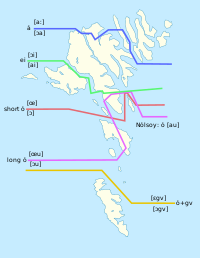Non-native pronunciations of English result from the common linguistic phenomenon in which non-native speakers of any language tend to transfer the intonation, phonological processes and pronunciation rules of their first language into their English speech. They may also create innovative pronunciations not found in the speaker's native language.
The phonology of Standard German is the standard pronunciation or accent of the German language. It deals with current phonology and phonetics as well as with historical developments thereof as well as the geographical variants and the influence of German dialects.
The phonology of Portuguese varies among dialects, in extreme cases leading to some difficulties in intelligibility. Portuguese is a pluricentric language and has some of the most diverse sound variations of any language. This article on phonology focuses on the pronunciations that are generally regarded as standard. Since Portuguese is a pluricentric language—and differences between European Portuguese (EP), Brazilian Portuguese (BP), and Angolan Portuguese (AP) can be considerable—varieties are distinguished whenever necessary.
The phonology of Catalan, a Romance language, has a certain degree of dialectal variation. Although there are two standard varieties, one based on Central Eastern dialect and another one based on South-Western or Valencian dialect, this article deals with features of all or most dialects, as well as regional pronunciation differences.
The sound system of Norwegian resembles that of Swedish. There is considerable variation among the dialects, and all pronunciations are considered by official policy to be equally correct – there is no official spoken standard, although it can be said that Eastern Norwegian Bokmål speech has an unofficial spoken standard, called Urban East Norwegian or Standard East Norwegian, loosely based on the speech of the literate classes of the Oslo area. This variant is the most common one taught to foreign students.
The Uralic Phonetic Alphabet (UPA) or Finno-Ugric transcription system is a phonetic transcription or notational system used predominantly for the transcription and reconstruction of Uralic languages. It was first published in 1901 by Eemil Nestor Setälä, a Finnish linguist.
Old English phonology is necessarily somewhat speculative since Old English is preserved only as a written language. Nevertheless, there is a very large corpus of the language, and the orthography apparently indicates phonological alternations quite faithfully, so it is not difficult to draw certain conclusions about the nature of Old English phonology.
There is significant phonological variation among the various Yiddish dialects. The description that follows is of a modern Standard Yiddish that was devised during the early 20th century and is frequently encountered in pedagogical contexts.
Dutch phonology is similar to that of other West Germanic languages, especially Afrikaans and West Frisian.
Unlike many languages, Icelandic has only very minor dialectal differences in sounds. The language has both monophthongs and diphthongs, and many consonants can be voiced or unvoiced.
In phonetics and phonology, relative articulation is description of the manner and place of articulation of a speech sound relative to some reference point. Typically, the comparison is made with a default, unmarked articulation of the same phoneme in a neutral sound environment. For example, the English velar consonant is fronted before the vowel compared to articulation of before other vowels. This fronting is called palatalization.
This article is about the phonology and phonetics of the Estonian language.
This article is about the phonology and phonetics of the Slovak language.
Afrikaans has a similar phonology to other West Germanic languages, especially Dutch.
This article aims to describe the phonology and phonetics of central Luxembourgish, which is regarded as the emerging standard.
This article covers the phonology of the Orsmaal-Gussenhoven dialect, a variety of Getelands spoken in Orsmaal-Gussenhoven, a village in the Linter municipality.
Hasselt dialect or Hasselt Limburgish is the city dialect and variant of Limburgish spoken in the Belgian city of Hasselt alongside the Dutch language. All of its speakers are bilingual with standard Dutch.
This article covers the phonology of the Kerkrade dialect, a West Ripuarian language variety spoken in parts of the Kerkrade municipality in the Netherlands and Herzogenrath in Germany.

